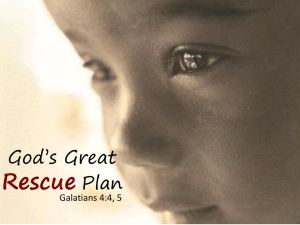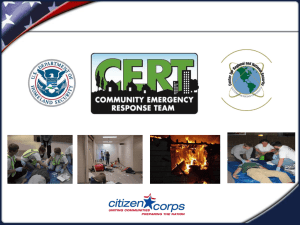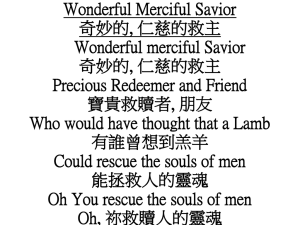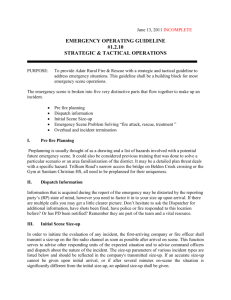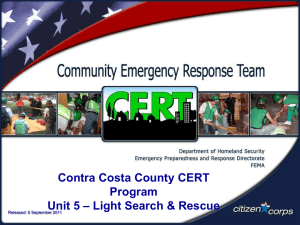Basic Fire Attack - Dallas Fire Rescue Explorers
advertisement
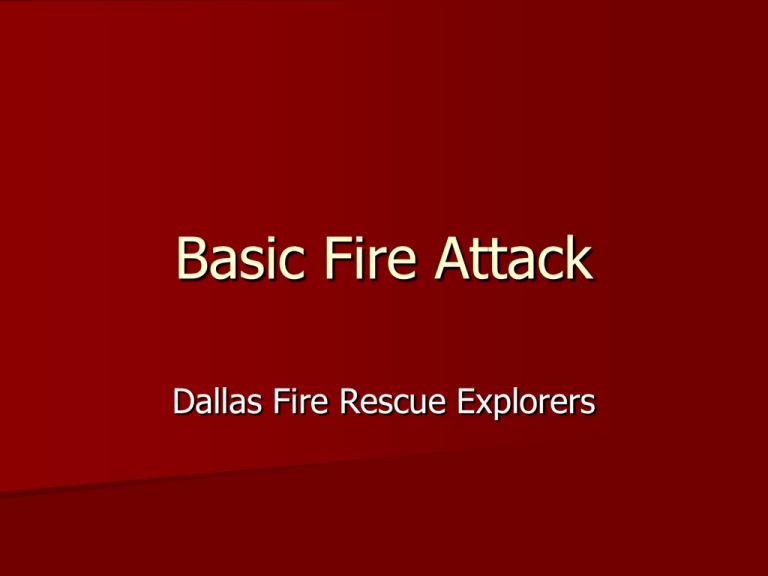
Basic Fire Attack Dallas Fire Rescue Explorers Basic Fire Attack Overview of Fire Attack Rescue Activities Exposure Protection Fire Confinement Fire Extinguishment Overhaul Ventilation Property Conservation Coordinated Fire Attack Rescue Immediate rescue attempted only in extreme cases Aid rescue by placing protective streams between victims and fire Water is essential to search & rescue operations Primary function during rescue is to contain fire and keep it from spreading Water Essential to Rescue Separate fire from people closest to it Control interior stairways and corridors for evacuating occupants and advancing firefighters Protect firefighters searching above and around the fire Exposure Protection Convection Radiation Conduction Convection Travel of heat through motion of heated matter Convection Smoke Hot air Heated gases Flying embers Convection Presents greatest fire fighting problem Smoke moves vertically and horizontallymushrooming A separate fire may ignite from hot air and combustion products rising Radiation Travel of heat through space (electromagnetic waves) Radiation Unaffected by wind Radiated evenly in all directions Will pass through water; stream must be directed on surface Travel blocked by solid surfaces Can pass through glass Conduction Travel of heat through a solid body Conduction Through walls and floors by way of pipes, metal girders and joists. May cause steel building and roof supports to collapse. Exposure Protection Second only to rescue on list of basic objectives Structures near fire building (exterior exposures) and parts of fire building not involved (interior exposures) Exposure Protection Exposure Coverage Interior Exposures Exterior Exposures Exposure Coverage Structure or materials closest to fire covered first When exposures are fairly close, most vulnerable areas just above fire Interior Exposures Fire in concealed spaces, especially in walls, ceilings and floors Vertical fire spread Horizontal fire spread Open interior spread Exterior Exposures Spacing between fire and exposure Building construction and materials Intensity and size of fire Location of fire Fire Confinement Activities Determine Fuel Load Establish Water Supply Select Adequate Hose Lines Basement Fires Determine Fuel Load Consists of interior surfaces, furnishings and contents for interior fires Exterior surfaces when fire has extended Factors affecting fuel load Type of fuel involved Quantity of fuel Arrangement of fuel Establish Water Supply Hose lays can be accomplished with either single or multiple lines, dependent upon A. flow requirements B. length of lay C. size of hose Select Adequate Hose Line Consider limitations of various size hoses Basement Fires Use all openings for attack Requires full ventilation of basement and first floor Stairways and other openings major channels for vertical spread Know escape routes Communications Fire Extinguishment Activities Effective Stream Operation Back-Up Lines Advancing Lines Choosing Right Line More than One Line Effective Stream Operation Stay Low Position on same side of door Bleed line prior to entering Hit ceiling first if fire is rolling Sweep floor to cool contents Only open when fire is seen Direct at base if localized Effective Stream Operations Lower stream as advance is made to hit main body of fire Shut down when main fire is knocked down If is area is very hot and no fire found, consider fire below you Attacking basements should be done with straight stream Effective Stream Operations Fog should be restricted to unoccupied confined spaces If building is ventilated, fog stream may be used; no more than 30 degree angle Large intense fire can be knocked down with larger lines then make interior attack Back-Up Lines Used when initial lines cannot quickly control a fire Held in readiness for use in place of attack lines Stretched when not obvious initial attack put out fire Taken into building immediately after initial attack lines Back-Up Lines Position close to initial attack line Have charged and ready to use May be used by RIT operations if needed. Back-up with same size line of initial attack or larger Ideally from different pump Overhaul Activities Examine Fire Scene What to Look For Where to Look Examine Scene Make certain no trace of fire remains; hot spots Leave structure in as safe a condition as possible Pre-inspection to make sure overhaul is safe to do Personnel protective gear as needed and determined by command Safe air What To Look For Flames Smoke Heat (Thermal Imaging Camera) Strong odors Charring Holes in floors Unstable building systems Where To Look Walls and ceilings Areas above fire Shafts Cabinets and compartments Window and door facings Soffits Balloon Frame Construction Ventilation Defined The process of making openings in building or exposure to allow heat and products of combustion to leave the building Purpose of Ventilation Reduces danger to trapped victims and extends time for rescue Increases visibility Permits quicker entry and advancement Minimizes time it takes to find seat of fire Minimizes time it takes to find fire spread Decreases or stops fire spread Reduces chance of flashover or backdraft Results of Ventilation Depend on size and type of occupancy involved Depends on extent and location of fire Weather conditions Result of Ventilation Increases effectiveness of all operations Aids in saving lives Openings allow heat and combustion products to exit by natural convection Windows can be opened; not automatically broken PPV fans and smoke ejectors Hydraulic ventilation Coordinated Fire Attack Staffing single most important part of engine company Failure to consider safety could be negligent on part of leadership of department Coordinated Fire Attack At least two (2) firefighters enter IDLH atmosphere and remain in visual or voice contact at all times At least two (2) firefighters are located outside the IDLH atmosphere for rescue Lack of additional personnel is not meant to preclude firefighters from performing emergency rescue activities before an entire team has assembles Coordinated Fire Attack Size-Up The sequence of thoughts and mental activity carried out by the individual in charge Size-Up Begins upon receipt of alarm May be carried out many times and by different individuals during the alarm Responsibility initially lies with officer in charge of first arriving unit As higher ranking officers arrive, command can be passed Size-Up Properly done will result in safe, timely, and efficient control of an emergency situation Care to be exercised to insure the total problem is evaluated Must be dynamic, continuing throughout all phases of the operation Size-Up for Rescue Officer of first arriving unit must first consider the rescue problem and determine if such conditions exist Risk/Benefit Size-Up for Rescue Problems found for rescue, all activities undertaken should be directed towards relieving the rescue problems All resources and activities should be directed towards fixing rescue problem Nothing done by way of an attack effort should interfere with or restrict rescue efforts Allocation for tools & equipment should favor those involved in the rescue effort Size-Up for Rescue Ventilation, point of entry and the placement of hose lines should be aimed toward protecting those in immediate danger and the crews involved in rescue efforts Possible that hose lines will be used to support rescue with no attempt to extinguish or even confine the fire Size-Up for Rescue Time is critical, each minute of continued exposure of victim reduces chances for safe rescue Life safety is first and primary consideration in all fireground activities Size-Up for Confinement First concern must be for adjacent exposures to which fire can spread Attack must be toward cutting off route of fire to uninvolved structures or exposures Attacking only main body of fire with no thought to exposures could result in larger fire Size-Up for Confinement First extension is normally vertical Unable to spread vertically with result in horizontally or crawling If both vertical and horizontal spread are prohibited, fire will spread down Working knowledge of building construction features will assist in preventing spread of fire Size-Up for Confinement Fire will continue to burn unchecked unless: 1. All fuel is consumed (we lost it) 2. Oxygen supply is depleted 3. Rate of heat release is reduced to a point where the process is no longer sustained Size-Up for Extinguishment Nature of fuel involved Quantity of fuel involved Physical arrangement of fuel involved Accessibility Rural or City Water Personnel Capabilities Fuels Involved Flammable liquids Combustible liquids Polycarbonate solids Ordinary combustibles Special hazards Accessibility Apparatus Size of building Type of construction Security Feature Time of Day

